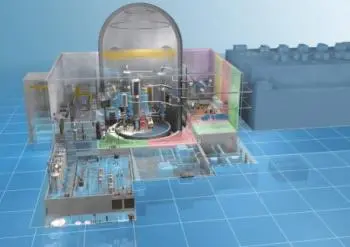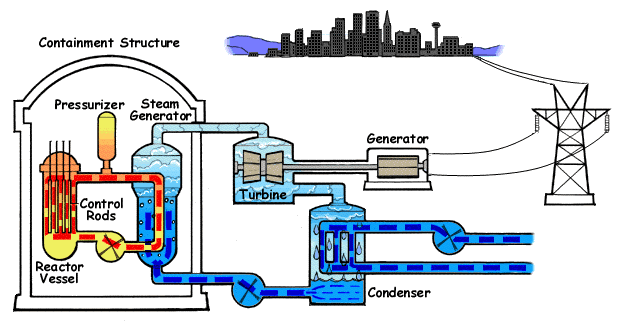
A pressurized water reactor is a nuclear reactor in which the water flowing uses high pressure in the primary circuit to prevent it from boiling. Otherwise, the high temperature inside the reactor would convert the heat water into steam.
It is currently the most widely used type of nuclear reactor in nuclear power plants worldwide in order to generate electric power. There are more than 230 nuclear reactors worldwide built up with this system.
The first purpose of the PWR model was to use it in a nuclear submarine.
Pressurized water reactors (PWR) use enriched uranium as nuclear fuel.
Along with boiling water reactors (BWR), the pressurized water reactor is a light water reactor.
How does a pressurized water reactor work?
The pressurized water reactor (PWR) works in 4 steps:
-
The reactor core within the reactor vessel generates heat through fission reactions.
-
The high-pressure water from the primary circuit transports this thermal energy to a steam generator outside the pressure vessel.
-
Inside the steam generator, the heat coming from the primary circuit converts the water from the secondary circuit into steam.
-
The steam generated drives a turbine that produces electricity.
The pressurized water reactor PWR has converted nuclear energy from nuclear fuel into electrical energy during these four points. Then, the cycle begins again: the resulting steam is converted back into liquid water through a condenser.
The condenser puts the secondary circuit in thermal contact with a tertiary course through which cold water circulates outside (seawater, rivers, lakes, etc.). Once the condenser has converted the steam into liquid water, it returns to the steam generator driven by a series of water pumps.
Pros and cons of pressurized water reactors (PWR)
PWR reactor advantages:
-
PWR-type reactors are very stable due to their tendency to reduce their power when the temperature increases.
-
PWRs can be operated with a core that contains less fissile material than is necessary to reach the prompt critical conditions with instantaneous neutrons. It reduces the possibility of the reactor having an uncontrolled power surge making it safer.
-
PWRs can use ordinary water as a moderator instead of requiring heavy water.
PWR nuclear reactor disadvantages:
-
The water in the primary cooling system must be highly pressurized to keep the water in the liquid phase. However, it increases construction costs and the risk of an accident with the loss of refrigerant from the primary system.
-
PWRs cannot change spent fuel while they are operating.
-
Hot water from the primary with dissolved boric acid is corrosive to stainless steel, causing corrosion products (which are radioactive) to circulate through the primary circuit. It limits the reactor’s useful life and requires unique systems for filtering corrosion products.
-
Ordinary water is more absorbing of neutrons than heavy water. Therefore when using regular water as a moderator, it is necessary to use enriched uranium as fuel, which increases fuel cost.
-
Since water acts as a neutron moderator, building a fast reactor with a PWR design is impossible.
The reactor core and nuclear reactions
The reactor core contains nuclear fuel rods. Inside, the atomic reactor generates a large amount of thermal energy.
The PWR pressurized water reactor cannot exceed a specific temperature to avoid melting for safety reasons. The reactor coolant system keeps the fuel rods at the right temperature.
The cooling is carried out using water that circulates thanks to a set of reactor coolant pumps.
The reactor must do the heat exchange between the primary and secondary without the water mixing because the water in the primary circuit is radioactive.

Coolant for pressurized water reactors
Ordinary water is the coolant used to keep water at the right temperature. In the field of nuclear engineering, it is called light water. The water can reach up to 315 degrees Celsius but remains in the liquid phase due to the high pressure (around 16 megapascals) at which the primary circuit operates.
Nuclear moderator in pressurized water nuclear reactors
Nuclear fission reactions occur when a neutron collides with a fuel atom. This collision results in two smaller fragments and one or two fast, free neutrons.
The pressurized water reactor (PWR) requires fast neutrons to slow down to generate more reactions.
The moderator is in charge of the neutrons losing speed. The water used as a coolant in PWR reactors also acts as a neutron moderator.
Another way to control power reactors is by using control rods that can absorb neutrons. Introducing them deeper into the reactor makes the reactions go down.

